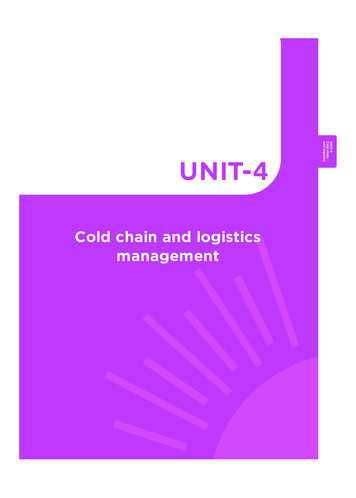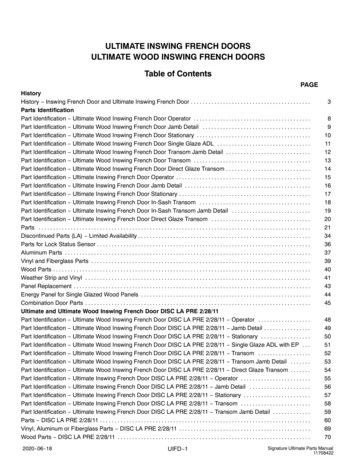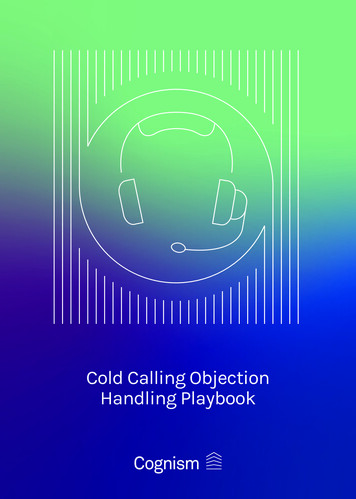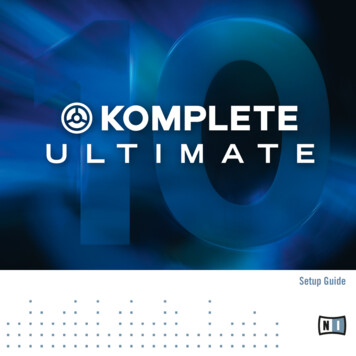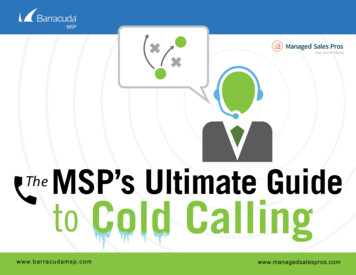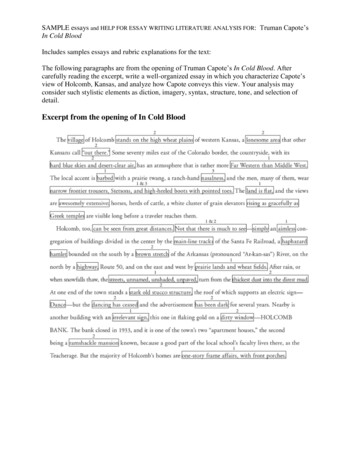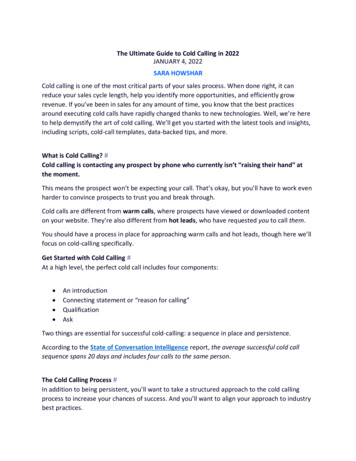
Transcription
The Ultimate Guide to Cold Calling in 2022JANUARY 4, 2022SARA HOWSHARCold calling is one of the most critical parts of your sales process. When done right, it canreduce your sales cycle length, help you identify more opportunities, and efficiently growrevenue. If you’ve been in sales for any amount of time, you know that the best practicesaround executing cold calls have rapidly changed thanks to new technologies. Well, we’re hereto help demystify the art of cold calling. We’ll get you started with the latest tools and insights,including scripts, cold-call templates, data-backed tips, and more.What is Cold Calling? #Cold calling is contacting any prospect by phone who currently isn’t “raising their hand” atthe moment.This means the prospect won’t be expecting your call. That’s okay, but you’ll have to work evenharder to convince prospects to trust you and break through.Cold calls are different from warm calls, where prospects have viewed or downloaded contenton your website. They’re also different from hot leads, who have requested you to call them.You should have a process in place for approaching warm calls and hot leads, though here we’llfocus on cold-calling specifically.Get Started with Cold Calling #At a high level, the perfect cold call includes four components: An introductionConnecting statement or “reason for calling”QualificationAskTwo things are essential for successful cold-calling: a sequence in place and persistence.According to the State of Conversation Intelligence report, the average successful cold callsequence spans 20 days and includes four calls to the same person.The Cold Calling Process #In addition to being persistent, you’ll want to take a structured approach to the cold callingprocess to increase your chances of success. And you’ll want to align your approach to industrybest practices.
Chorus.ai has analyzed data from millions of cold calls across more than 300 organizations tobetter understand how top-performing teams work their cold calling process. Our analysis hasshown that: The average length of cold calls that convert into a next step is 7.5 minutes.Reps talk for 40-45% of the conversation and ask four questions, including two to threeengaging questions that solicit responses of 30 seconds or more.Prospects typically ask five to six questions. Topics like discounts, pricing, andcompetitors come up one to two times each.We’ve also found through our research that in an ideal cold call, both the rep and prospect willeach engage in a monologue for more than 30 seconds. So, it’s really important for sales prosto be confident and engaging when making a cold call. With that in mind, let’s dive into thetwelve cold calling tips that can help you to succeed. Compare your current cold-calling processand results to companies of a similar size and Average Contract Value (ACV) to see how youstack up.What a typical cold call to close funnel looks likeEver wonder how many cold calls it takes to close a deal? Here are the industry averagesaccording to our call recording data:12 Cold-Calling Tips and Best Practices #Now that you know what an ideal cold call looks like and sounds like, let’s dig a little deeperinto some of the best cold-calling techniques.1. Be Strategic and Prepared #Never go into a cold call, cold. You need to do your prep, just as you would for any other salescall. Also, avoid the rookie mistake of reaching out to unqualified prospects—you want to focuson pursuing quality. Here are some key resources to consult before you pick up the phone: Dedicated account lists, including strategic and named accounts with owners. You canscore and prioritize the accounts by key criteria that matter most to your business, such
as hiring in certain divisions, new location openings or product launches, budget orheadcount, and immediacy of the account’s planning season.Detailed personas for your top prospects, including detailed explanations of how theyquantify a return on investment (ROI), and what their needs, challenges, and passionpoints are.Research top accounts, including trends impacting their industry, related tools they use,and recent company news you can reference.Cold call scripts that leave room for personalization and can help you manage commonobjections and address FAQs.2. Fill Out An Account Planning Template #Outline your plan of attack - prioritizing key accounts and opportunities first.
3. Bring the energy on cold-calls #As noted earlier, you need to be confident on cold calls if you want to break through withprospects who weren’t expecting to hear from you in the first place. Being energetic can helpyou exude confidence.To boost your energy, consider the following: o Standing up during the call (such as power posing)o Speaking louder than normal by projecting your voice (not shouting, though)o Over-emphasizing key phrases to capture a prospect’s attention4. Focus on learning and engaging, not selling #The key to a successful cold call is getting a prospect to open up. You don’t have much time, sowork quickly to create “engaging moments” during your conversation. These are momentswhen you’re connecting with your prospect so effectively, that they’re excited to share withyou for 30 seconds or longer. (At Chorus.ai, we measure engaging moments in terms of
prospect talk time on a call. The longer the prospect monologue, the more engaging themoment was.)How do you create engaging moments? With engaging questions, of course! These are openended questions that prompt responses of 30 seconds or longer. Here are a few examples: How are you currently approaching [challenge] at [company]? What tactics andplatforms do you use?It seems like you already know a little bit about [topic/challenge]. What solutions haveyou explored thus far?Now that you know a little bit about what we do, what questions might you have forme?Is there anything that might stand in the way of us continuing our conversation later?5. Drive toward an “ask” or next step #One of the most important cold calling tips we can offer is to always remember that the coldcall is not the forum for trying to close a deal. Instead, you want to use this conversation to helpmove a prospect toward the next step in the sales process by trying to understand: If your prospect has a clear need/challenge you can help to solveHow much the prospect knows about your categoryWhether anyone else should be involved in the purchase decision-making processIf the prospect is just starting to explore options or if they’d be interested inimplementing a solution soonWhat the prospect needs from you to move forward in the sales processIn short, a cold call should help you learn if the account is qualified and what the next stepshould be to advance the discussion. That next step might be setting up a discovery call or ademo, depending on how educated your prospect is and how much information you gatherduring the cold call. Or perhaps you simply need to send some collateral, like a case study, andthen offer to engage with the prospect later when they’re ready to talk details.Pro tip: While it can be tempting to ask about the budget during a cold call, we suggest avoidingthis topic unless the prospect is clearly educated and looking to buy in your category soon. Thatsaid, it’s still a good idea to have some talk tracks around pricing at your fingertips, just in casethe conversation pivots in that direction.6. Anticipate common objections and FAQs #We mentioned that it’s important to have best-in-class responses for common objections andFAQs.Our call recording data shows that prospects will ask 5-6 questions on cold-calls. Prospects alsotend to bring up objections around budget, pricing, and competitors at least once early on.
While this may seem challenging, it’s generally a good sign that your prospect is educated onthe market, and educated prospects are more likely to close.Here are some examples of common cold call objections that come up on:“I’m just not interested.” Try saying: “I understand, NAME. So are you saying that X challenge is not important toyou in your role at COMPANY?”Or, “Can you help me find someone else at COMPANY who may be more focused on Y?”“We already use X competitor” Try saying: “We’re very familiar with X COMPETITOR. How are they working out for youso far – are you seeing the results you’d hoped for? Is there anything that could beimproved?”“This seems like it’d be too expensive for us.” Try saying: “We heard something similar from X COMPANY and they were able to driveX RESULTS/ROI. What worked for them was Knowing that, would you reconsiderlearning more?”“I don’t have time to talk right now.” Try Saying: I can tell I caught you at a bad time, so I’ll get straight to the point “I don’t think this will work for us right now.” Try Saying: “I’m curious to know why you feel that way, especially because we’ve had somuch success with similar companies. Can you help me understand by explaining a littlemore about why you think this isn’t a fit for X COMPANY right now?”7. Embrace rejection on cold calls #Rejection happens. And it happens a LOT when you’re cold-calling. In fact, according to theState of Conversation Intelligence, the average connected cold call only lasts 80 seconds long.Only 10% of cold-calls last longer than 2 minutes – and that’s if the prospect even picks up!When you face a rejection, ask the prospect for feedback. You could say, for example: “Iappreciate your honesty. The hardest thing about my job is not knowing whether we can helpsomeone. Do you mind telling me why you don’t think we can help you?”Cold calling can be a drag and a morale-bruiser, especially when you encounter people who aredownright rude when they reject you. So, it’s important not to take things too personally, andto find humor where you can. You might consider creating a Slack channel for your team, whereyou can share funny stories about your cold calling experiences.
Coaching and practicing will also help you learn to deal with rejections smoothly and avoidletting the prospect turkeys get you down.(Later in this post, we offer some tips for selfcoaching, peer coaching, and more.)8. Use voicemails alongside cold-calls #Our analysis of sales call data shows that 90% of cold calls will result in a voicemail. This isn’tnecessarily a black hole. Think of it as an opportunity to make a warm connection with aprospect, or to offer something of value that will inspire the prospect to call you back.Try using these voicemail strategies in your cold calling process: Warm introductions: “NAME, X person in X division recommended that we speak today,which is why I’m calling.”Personalization: “NAME, I’ve been thinking about X COMPANY, and I’m going to sharesome ideas by email to solve X CHALLENGE. I will call again early next week to get yourfeedback on the ideas I shared and would really appreciate your feedback.” (Then,connect with the prospect on LinkedIn.)Establishing credibility: “NAME, I’m calling because I’ve helped X SIMILAR COMPANYaddress X CHALLENGE and wanted to share some ideas with you. I’ll follow up with acase study by email, but I’ll call again next week to go through it with you and see if youhave any questions.” (Here again, connect with the prospect on LinkedIn.)When leaving voicemails as a cold caller, here are some do’s and don’ts you’ll want to keep inmind: DO keep voicemails under 20 seconds or lessDO leave your name and info last0—lead with valueDO use an upbeat, friendly, and energetic tone of voiceDO incite some urgencyDO use your prospect’s name and your nameDON’T try to sell in the voicemailDON’T leave only one voicemail—follow up9. Use social selling alongside cold-calls #Social selling is also a great way to bolster your cold-call process and help prospects better put aface to the name.What is social selling?Social selling is contacting any prospect on social media channels, such as LinkedIn or Twitter,by requesting to connect, sending a private messaging, addressing them in conversation viacommunities and threads, or commenting on content they shared. The goal of social selling is tobuild awareness and learn about prospects. Social selling can also be used to set up meetings,such as discovery calls.
When it comes to social selling, here are some best practices to consider: Show up and really engage. Don’t automate things. Be yourself!Address things you have in common, such as your university or mutual connectionsDon’t pitch - provide valuable information that shows you’re an expert in your field10. Employ the right technologies #Technology plays a key role in making your cold calling process more efficient and effective. So,in addition to maximizing the cold calling tips outlined above, you’ll want to ensure you andyour team are employing the right technologies. There are many resources on the markettoday, and they generally fall into the following categories: Automation platforms, for manually automating tedious tasks such as dialing,navigating phone trees, waiting on hold, talking to gatekeepers, and scheduling followups.Full sequence management platforms, which integrate cold calling into your salesprocess alongside tactics like phone, email, SMS, and social.Conversation Intelligence (CI) platforms, like Chorus.ai, which record cold calls and pullthe transcripts into your customer relationship management (CRM) system. You can useCI platforms to pull insights from cold calls to improve your talk tracks and conversions.And you can build coaching pathways and certifications for reps so they can improvetheir cold calls and benchmark against top performers.Contact data platforms, which provide accurate emails and phone numbers for prospects, aswell as insights on how to personalize your cold calls based on recent account news.11. Use KPIs to measure success #You also need to measure your cold calling success. As a general rule of thumb, if you canconvert 30-40% or more of your connected cold calls into a meeting, you’re doing a fantasticjob. Consider using the following cold call KPIs as a starting point for tracking your performance:Inputs: Monthly revenue goalAverage deal size% of cold calls that closeMonthly goals: X dialsX connectsX cold-calls that move to late stagesX closed won dealsWeekly goals:
X dialsX connectsX cold-calls with next steps12. Prioritize coaching on cold calling #Even if you have all the right tools, best practices, and other resources in place for cold calling,you’re not going to be successful if your team isn’t receiving coaching. Coaching processesinclude: Self-coaching: Reps can listen to their recorded calls and their peers’ calls alongside arubric.Peer coaching: This process might entail each rep commenting on a teammate’s coldcall, highlighting two positives and two things to improve.Manager-led coaching: This type of coaching usually takes place in one-to-ones, wherethe rep presents one of their cold calls to their manager for review and analysis.Typically, in these sessions, the manager will focus on helping the rep develop a specificskill, such as how to handle objections or ask engaging questionsGroup film review: This process occurs when a rep submits a cold call for review and theentire group shares feedback. The person who submitted the call first self-critiques thecall before the entire group weighs in.We hope you find these cold calling tips and best practices useful in helping you and your teamto become more successful at turning prospects who weren’t expecting you to call them intocustomers who are very happy that you did.Two Cold-Calling Scripts to Help Your Team Schedule More MeetingsDECEMBER 16, 2021SHAWN PARROTTECold calling is probably the hardest thing to do in sales. The process isn’t designed to makesales development reps and sales reps successful, so they need as much help as they can get toovercome obstacles and objections. That’s why cold calling scripts can be so handy.In this post, we offer two examples of cold calling scripts that cater to two distinct rep types.One will suit more methodically minded reps, and the other is for more improvisatory reps. Nomatter which type of rep you align closest to, these two cold calling scripts should help you tohave more productive cold calls — and land more scheduled meetings.What Is Cold Calling? #Cold calling is defined as any unsolicited sales call. After rigorous prospecting to determine thecompanies (and the decision-makers and gatekeepers) to approach, sales reps will pick up thephone. Sometimes, they’ll have to make multiple phone calls to reach a potential customer,which is why voicemails and cold emails are also important tools for outreach.The core purpose
of a cold call is to land a meeting with a prospect. That’s when you can really sell your valueproposition and get the sales process moving in earnest.Cold Calling Key to Success: Effective Prospecting #Notice that in the definition of cold calling above, we note that this process follows “rigorousprospecting.” That’s because effective prospecting is a must if you want more of your cold callsresult in scheduled meetings — and fewer immediate hang-ups.You can generate solid leads through both inbound and outbound prospecting: Inbound prospecting involves enticing your prospects to your site using methods likecontent marketing and search engine optimization (SEO). When they register interest onyour site, it’s a sign that they’ll likely be more receptive to a cold call.Outbound prospecting is when your sales development pros actively pursue potentialleads through channels such as Google, LinkedIn, or other social media. Cold emails arealso a form of outbound prospecting.Some Cold-Calling Facts #At Chorus.ai, we analyzed over 1 million cold calls using sales engagement products such asOutreach. We found a number of interesting statistics that can inform your cold-calling efforts.The average duration of all connected cold calls is just over a minute—not everyone likes beingcold-called! But the key to a successful cold call is to ensure that you have a longerconversation.Only 10% of connected cold calls last more than two minutes, which means it’s difficult to crafta long conversation. The best cold-calling team strategy and coaching process need to focus onhow to have longer, more meaningful conversations.The average successful cold call (that resulted in a longer discovery meeting) lasts 7.5 minutes.This suggests that longer conversations are closely correlated with success. How do you makeconversations longer? The secret clearly lies in how you use the first few minutes of theconversation. Are you interesting, intriguing, and likable on the phone? Can you build rapportwith your prospect? Do you have an interesting story and some soul-searching questions thatmake the prospect reluctant to hang up and get back to their computer?The answer to all these questions, of course, must be yes. And cold-call scripts are handy forhelping make this happen.The Science of a Cold-Calling Script #The logic behind having a cold-calling script is to make it easier for reps to hit all the marksrequired to turn initial contact into a scheduled meeting. Along with building rapport, it’snecessary to use a cold call to identify customer pain points and cement your prospect’s idea of
your value proposition. There’s no point in trying to advance a deal with a customer whostraight-up doesn’t need your product.Asking open-ended questions to get your prospect to open up is a key component of any coldcall and can be scripted to powerful effect.Here are some examples of effective open-ended questions: What are your main priorities right now as a business/a [professional]?What do you see as the main problem you’re trying to solve at the moment as abusiness?What would the ideal solution look like to you?What information do you need or what KPIs do you consult before making a purchase?The point of these questions is to allow your prospect to fill in gaps in your knowledge so youcan tailor your sales process to their needs and pain points. Needless to say, sales reps can’t beentirely passive on a cold call. Sales reps must be handy with follow-up questions to move theconversation along smoothly, and they must able to deal with common objections. Strive tomake your product’s impact on the prospect’s bottom line and everyday processes very clearfrom the get-go.Turning Best Practices into Scripts #Phone calls might still be where the sales action is even post-COVID-19, but cold calls areintense environments that managers need to help their sales team handle with effectivescripts.Good sales managers will operate from the understanding that not all of their sales teammembers are alike in skills, disposition, or preferred processes. Not all sales reps will have anidentical relationship with a sales script. As Nancy Nardin, founder of Smart Selling Tools Inc.and a co-founder of Vendor Neutral advised:“If you've been told to use a script that doesn't feel like you, find a way to make it more naturalto you.”The first will suit process-driven reps, as it’s composed of a series of methodical steps that theycan repeat on one call after another. The second will be better for reps who do their best workin a more spontaneous manner and are excellent at building rapport; in other words, theytypically don’t like using a sales script. But this template provides a framework that will let themwork freely without neglecting the fundamentals.The Systematic Cold-Calling Script #This first example is well-suited for process-driven reps, as it has a series of steps that you canrepeat on every cold call. Systematic cold calling scripts can be effective for reps who are skilledat executing within clear bounds. It will help you attack your cold calls more confidently andsmoothly, resulting in a higher volume of successful calls and scheduled sales meetings.
Here’s how a cold call might play out when you use a systematic approach:Prospect: Hello?Rep: Hi, [Prospect Name], this is [Rep] from [Company Name]. How have you been?Prospect: Fine May I ask why you’re calling?Rep: Great question! Can I have 20 seconds of your time to answer that?Prospect: OK, sure Rep: I noticed on LinkedIn that you recently moved into X position at your firm, and I thoughtwe should connect. Our company provides [Product/Solution] that helps teams like yoursperform better. We know from working with other firms in your industry that your organizationis likely struggling with [describe pain point]. I’d like to explain how we can help you addressthat issue and Prospect: I’m afraid I don’t have time right now, but thanks anyway.Rep: I know that I called you unannounced today, but I do believe this information will beuseful to you. Could I call you again on Thursday, around 2 p.m.? Would that time work well?Why this approach works: Using a greeting like “How have you been?” can be disarming, as it implies that you andthe prospect already have a pre-existing relationship.Asking for a specific amount of time to give your (brief and well-rehearsed!) elevatorpitch can be comforting to the prospect — you’re promising to be efficient andrespectful of their time, and they know they don’t have to hang on the line for very long.In the scenario above, the rep references LinkedIn to help spark a conversation andbuild instant rapport. If you use this strategy, it shows the prospect you’ve done yourresearch.Remember, the cold call isn’t when you try to close a deal — you want to get a scheduledmeeting. The rep in the scenario above uses the prospect’s deflection as an opportunity toschedule that meeting — and get the prospect to commit to a specific time and date. When youdo the same, be sure to reach out to the prospect with a supplemental follow-up email and acalendar invite to cement your meeting time.Don't Skip a Beat When Onboarding Your CustomerDOWNLOAD THE HANDOFF PROCESS OPTIMIZING EBOOKThe Freewheeling Cold-Calling Script #Next up is a cold calling script that’s ideal for reps who do their best work in a morespontaneous manner and are excellent at building rapport. In short, these are the reps who
don’t typically like using a sales script! If this describes you, know that this template provides avaluable framework that will let you “do your thing” while also helping you keep fundamentalsin focus.This open-ended approach to cold calling emphasizes personalization and relationship-building.More business owners and executive decision-makers are joining sales calls these days. In lightof that trend, and the fact that effective relationship management is central to ongoing SaaSsuccess, the freewheeling option can be a strong choice among cold calling scripts.Here’s how a cold call might play out when you use a freewheeling approach:Prospect: Hello?Rep: Hi, [Prospect Name], this is [Rep] from [Company Name]. How have you been?Prospect: Fine May I ask why you’re calling?Rep: Absolutely. Our company provides [Product/Solution], and we’re working with businesseslike yours to resolve critical issues that are hurting profitability. Let me ask you this: What doyou see as the main problem your organization is trying to solve right now?Prospect: Well, we’ve been dealing with this one issue [describes issue]Rep: Thanks for sharing that! We know a lot of companies are struggling with that exactproblem. I’m confident we can help you, too, and here’s why [explains why, using data pointsto underscore customer results/product value]. Does this sound like a good option for you?Prospect: Maybe I’m not sure, though. I need more information.Rep: Of course! Let’s set up a call to discuss this opportunity in more detail. How about nextThursday at 2 p.m.?Why this approach works: First, note that the freewheeling approach starts out like the systematic approach. Allcold callers need to maximize the value of those key moments after a prospect picks upthe phone.After the rep in the scenario above gives a brief elevator pitch, they use an open-endedquestion to get the prospect talking and turn the cold call into a conversation. Openended questions also help you establish your understanding of the prospect’s specificpain points.Note that the rep employs data to underscore the value of the solution and the resultsother companies are seeing. This is information — when used strategically during thecold call — that is likely to make a positive impression and stick in the mind of theprospect.
And similar to the systematic approach, the rep in the freewheeling scenario is alsomaking sure to schedule a meeting (and not try to pressure the prospect into a sale).Again, when you do this in a cold call, be sure to reach out with a supplemental followup email and a calendar invite to ensure things are set in stone.The freewheeling approach can work well for improvisatory sales reps. And, if the customer isreceptive to this approach, it can increase the likelihood of a sale. This warmer, less-formalizedsales script can help you understand where your customer really sees value in your product,and it can boost a vendor-client relationship in a way that can pay rich dividends over the longterm.Did you know? #Research from Chorus.ai shows that if a cold call is going well, the prospect will ask two or threequestions other than, “What do you do?” If this happens, it’s a great sign that the prospectfinds your proposition intriguing.So, use every opportunity to create engaging moments with the prospect (i.e., where they talkfor more than 30 seconds). According to our analysis of over a million cold calls, you want tocreate at least one or two of those moments — and asking open-ended questions can help youdo exactly that.For more tips on cold calling, download our free cheat sheet.Listen to the voice of your customers #So, after reviewing these two cold calling scripts, which approach do you think will work bestfor you? Systematic or freewheeling? In either case, you’ll be even more effective in the coldcall process if you take the time to listen to your prospects.Also, be sure to use cold calling scripts as guides for your conversations with prospects. Coldcalling scripts are not meant to be inflexible structures that dictate how every discussion shouldflow. While you have a clear goal in every cold call — getting a meeting scheduled — aim tomake the conversation as natural as possible. That will greatly improve your ability to create apositive and meaningful connection with a prospect that will keep them on the phone — andinterested in learning more.Also, to understand what messages and strategies will likely resonate best with the prospectsyou cold call, tap into the conversation intelligence Chorus.ai provides so that you can getinsight straight from the voice of your customers. And don’t miss our blog post, 12 Cold CallingTips and Best Practices to Make Better Deals, which offers even more insight on how tosucceed at cold calling.
focus on cold-calling specifically. Get Started with Cold Calling # At a high level, the perfect cold call includes four components: An introduction onnecting statement or "reason for calling" Qualification Ask Two things are essential for successful cold-calling: a sequence in place and persistence.


